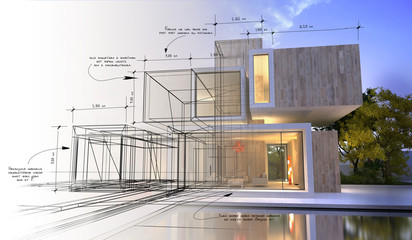House design is more than simply constructing walls and roofs—it is the art of creating a space that reflects your lifestyle, personality, and practical needs. A well-designed home combines aesthetics, functionality, and comfort to provide a sanctuary where daily life flows smoothly. Whether building a new home or renovating an existing one, exploring fresh design ideas can help homeowners maximize space, enhance visual appeal, and improve overall living quality. Understanding key principles, trends, and practical tips empowers anyone to transform their home into a stylish and functional haven.

The Importance of Thoughtful House Design
Thoughtful house design affects both the physical and emotional quality of life. A well-planned home enhances comfort, reduces stress, and promotes efficient use of space. Proper layout and design choices ensure that daily activities are convenient, while elements such as lighting, ventilation, and materials improve well-being and energy efficiency.
Beyond functionality, house design influences how a home feels. Open layouts, natural light, and harmonious color schemes create a sense of space and serenity, while poor design can result in cramped, dark, or inefficient areas. Investing in well-considered design ensures long-term satisfaction and increases the property’s value.
Maximizing Space with Clever Layouts
Effective house design starts with the layout. Smart space planning ensures that rooms are functional, connected, and visually appealing:
- Open-Plan Living: Combining kitchen, dining, and living areas promotes connectivity, natural light, and a sense of spaciousness.
- Multi-Purpose Rooms: Flexible spaces that serve as home offices, guest rooms, or play areas adapt to changing needs.
- Efficient Traffic Flow: Designing hallways, entrances, and doorways to minimize obstruction ensures smooth movement throughout the home.
- Zoning Private and Public Areas: Separating bedrooms and bathrooms from high-traffic living areas enhances privacy and comfort.
- Utilizing Vertical Space: Incorporating built-in shelving, lofts, or mezzanine levels maximizes storage and living area without expanding the footprint.
A well-thought-out layout is the foundation for a functional, comfortable, and enjoyable home.
Choosing the Right Colors and Materials
Colors and materials play a significant role in creating atmosphere, defining style, and enhancing durability:
- Color Schemes: Light, neutral tones make small spaces feel larger, while bold colors add personality and highlight focal points. Harmonizing wall colors with furniture and accessories creates visual balance.
- Natural Materials: Wood, stone, and bamboo introduce warmth, texture, and a timeless feel to interiors.
- Modern Finishes: Glass, metal, and polished concrete offer sleek, contemporary aesthetics and are often low-maintenance.
- Sustainable Choices: Using eco-friendly, locally sourced, or recycled materials reduces environmental impact and supports long-term sustainability.
The combination of appropriate colors and materials sets the tone for the home, balancing style and functionality.
Enhancing Natural Light and Ventilation
Natural light and proper ventilation are essential in house design, improving health, mood, and energy efficiency:
- Large Windows and Skylights: Bring in abundant daylight, making spaces feel brighter and more open.
- Open Floor Plans: Allow light to travel freely between rooms, reducing the need for artificial lighting during the day.
- Cross-Ventilation: Strategically placed windows and vents facilitate airflow, keeping interiors cool and fresh.
- Indoor-Outdoor Connection: Sliding glass doors, patios, or balconies provide seamless transitions to outdoor areas while enhancing light and ventilation.
Incorporating natural light and ventilation into design creates healthier, more inviting spaces and reduces energy consumption.
Incorporating Storage and Functionality
Smart storage solutions are vital to maintaining a tidy, organized home without sacrificing style:
- Built-In Cabinets: Custom shelving or closets integrate storage into the design, reducing clutter and freeing floor space.
- Under-Stair Storage: Transform unused spaces into practical storage areas or compact workstations.
- Multi-Functional Furniture: Beds with drawers, foldable tables, or seating with storage combine form and function.
- Walk-In Closets and Pantry Spaces: Provide dedicated storage for clothing, kitchen supplies, and household items, improving organization and accessibility.
Efficient storage ensures that the home remains functional and visually appealing without compromising living space.
Outdoor Spaces and Landscaping
House design is not limited to interiors; outdoor spaces enhance lifestyle and curb appeal:
- Patios and Decks: Ideal for entertaining, dining, or relaxation.
- Gardens and Green Spaces: Introduce color, texture, and environmental benefits while creating tranquil spaces.
- Balconies and Terraces: Offer private outdoor retreats with views, seating, and greenery.
- Water Features and Pathways: Add aesthetic interest, create focal points, and improve the flow of the landscape.
Integrating indoor and outdoor areas maximizes the usability of the property and creates a harmonious living environment.
Trending House Design Ideas
Modern design trends focus on sustainability, simplicity, and creativity:
- Minimalist Interiors: Prioritize clean lines, neutral palettes, and uncluttered spaces for calm and functional living.
- Sustainable Features: Solar panels, energy-efficient appliances, and rainwater harvesting systems support environmentally conscious living.
- Smart Home Integration: Automated lighting, climate control, and security systems enhance convenience and safety.
- Bold Accent Walls: Use textures, colors, or patterns to create focal points and add personality to rooms.
- Open Concept Kitchens: Combine cooking, dining, and social areas to enhance interaction and connectivity.
Trends evolve, but integrating these ideas can create a home that is stylish, modern, and tailored to your lifestyle.
Conclusion
House design is a blend of creativity, functionality, and personal expression. Thoughtful planning, smart layouts, proper color and material choices, natural light, efficient storage, and outdoor integration all contribute to a harmonious and livable home.
Incorporating modern trends such as sustainability, minimalism, and smart technology can elevate the home while ensuring comfort and efficiency. Whether designing from scratch or renovating, exploring diverse house design ideas allows homeowners to create spaces that are beautiful, practical, and reflective of their unique lifestyle.
A well-designed home is more than a shelter; it is a sanctuary where aesthetics, comfort, and functionality come together to support daily living, foster well-being, and inspire a sense of pride. By considering key design principles and creative ideas, anyone can transform their house into an inspiring and enduring space.